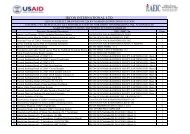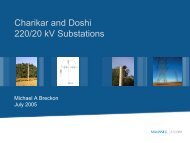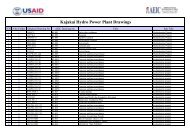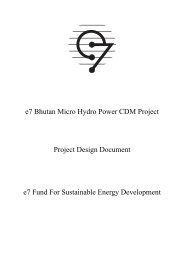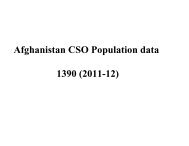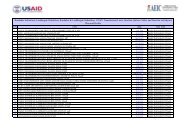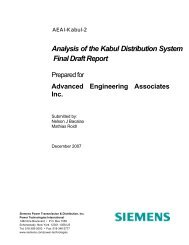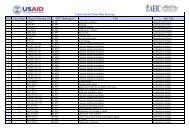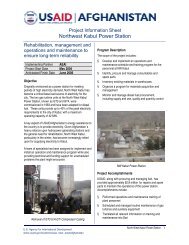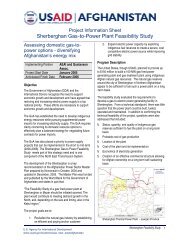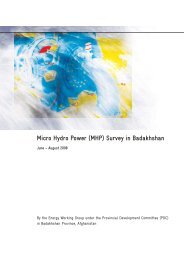prioritization and implementation plan - Cooperazione Italiana allo ...
prioritization and implementation plan - Cooperazione Italiana allo ...
prioritization and implementation plan - Cooperazione Italiana allo ...
You also want an ePaper? Increase the reach of your titles
YUMPU automatically turns print PDFs into web optimized ePapers that Google loves.
Government control will be an option, where<br />
necessary.<br />
• Governance, Rule of Law <strong>and</strong> Human Rights<br />
Pillar – The APRP will be administered with a<br />
high degree of transparency <strong>and</strong><br />
professionalism. In order to ensure the<br />
protection of human rights, the APRP will be<br />
open, transparent, <strong>and</strong> compliant with the<br />
Afghan Constitution.<br />
• Social <strong>and</strong> Economic Development Pillar – A<br />
National Community Recovery Program will<br />
be developed as a component of the National<br />
Solidarity Program III, with additional<br />
training, facilitation <strong>and</strong> operational guidelines<br />
for conflict affected areas. The National Rural<br />
Access Program will also benefit the<br />
communities where reintegration occurs, with<br />
employment <strong>and</strong> vocational training<br />
opportunities offered through infrastructure<br />
projects in priority districts. Both programs<br />
will be funded from the Afghan<br />
Reconstruction Trust Fund.<br />
Process, Activities, <strong>and</strong> Expected Results<br />
The APRP is a flexible <strong>and</strong> simple umbrella<br />
framework for funding reconciliation <strong>and</strong> national<br />
<strong>and</strong> local peace <strong>and</strong> reintegration activities from<br />
the Peace <strong>and</strong> Reintegration Trust Fund. The<br />
program delegates to the Afghan people, in<br />
Government <strong>and</strong> civil society, the central<br />
leadership role in building peace in their country.<br />
Three-Stage Process – The APRP proposes a<br />
three-stage peace <strong>and</strong> reintegration process<br />
presented below with program outputs for each<br />
stage.<br />
• Stage One – Social Outreach, Confidence-<br />
Building, <strong>and</strong> Negotiation: Provincial <strong>and</strong><br />
district leaders will conduct outreach to<br />
individuals <strong>and</strong> their communities who<br />
demonstrate their intent to join the peace<br />
process <strong>and</strong> will facilitate confidence-building<br />
activities, negotiations, <strong>and</strong> grievance<br />
resolution among the Government,<br />
communities, victims, <strong>and</strong> ex-combatants as<br />
necessary. The means for achieving this may<br />
include: peacebuilding capacity development<br />
<strong>and</strong> disseminating information about the<br />
program.<br />
• Stage Two – Demobilization: Those who join<br />
the peace process will be demobilized through<br />
a social <strong>and</strong> political process that begins with<br />
an initial assessment, vetting, weapons<br />
management, <strong>and</strong> registration. Immediate<br />
humanitarian assistance may be provided, if<br />
necessary.<br />
• Stage Three – Consolidation of Peace:<br />
Following the political <strong>and</strong> security processes<br />
of the first two stages, a st<strong>and</strong>ard needs<br />
assessment tailored to the requirements of the<br />
APRP will be used to assist communities,<br />
districts <strong>and</strong> provinces to select from a “menu<br />
of conflict recovery options.” Not all options<br />
will be available to every community, due to<br />
the challenges of access, capacity <strong>and</strong> security,<br />
<strong>and</strong> the diverse needs of different<br />
communities.<br />
• The “menu of options” includes but is not<br />
limited to: improving access to basic services,<br />
civic education, literacy, technical <strong>and</strong><br />
vocational education/training, <strong>and</strong><br />
employment. Other options include: the<br />
Community Recovery Program, an<br />
Agricultural Conservation Corps, a Public<br />
Works Corps, <strong>and</strong> also integration into the<br />
Afghanistan National Security Forces.<br />
APRP Scale <strong>and</strong> Scope – Immediate priority<br />
provinces for introduction of the program are<br />
Helm<strong>and</strong>, K<strong>and</strong>ahar, Nangarhar, Khost, Baghlan,<br />
Badghis, Kunduz, <strong>and</strong> Herat. However, the<br />
program is flexible <strong>and</strong> will respond to emerging<br />
opportunities in any province, depending on the<br />
availability of resources <strong>and</strong> capacity.<br />
Institutional <strong>and</strong> Organizational Development –<br />
The Joint Secretariat will be managed by a CEO,<br />
with the assistance of three Deputy CEOs for<br />
administration <strong>and</strong> logistics; program delivery; <strong>and</strong><br />
local conflict resolution <strong>and</strong> reconciliation. The<br />
existing capacity of the Peace through Strength<br />
(PTS) <strong>and</strong> Disarmament of Illegal Armed Groups<br />
(DIAG) programs will be utilized to support<br />
APRP, <strong>and</strong> a consolidated organizational structure<br />
will soon emerge.<br />
40





